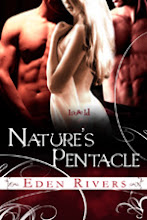
As in Nature’s Pentacle, I’ve returned to my delightfully lusty, supernatural witches in today’s Loose Id release Strange Sabbats (Buy Link and Excerpt). Strange Sabbats is structured around seasonal festivals celebrated by the witches in my story--festivals which are dear to my pagan heart.
I’d like to share a bit more about the Sabbats celebrated by Aileen, Bryan, and Sylvie in Strange Sabbats, but first, here’s the blurb from my new release:
Aileen sacrificed her power for the sake of her marriage, only to see her husband die in a car crash. When childhood friend Jon appears on the scene for a Yule celebration, the sex is scorching. But jealousy gets in the way of true love, until Aileen's power returns--and so does Jon.
Aileen's brother, Bryan, still carries a torch for Jon, and fears revealing himself to humans. But when he includes his human friend Dallas in an erotic Beltane ritual, it's clear who holds the whip in that relationship.
Jon's Aunt Sylvie has the erotic relationship of a lifetime with Ty, a younger man--until she's offered a CEO position in New York. On the night of the summer harvest festival, Ty makes Sylvie's most wanton fantasy come true by inviting another woman into their bed.
For three witches related by blood and common circumstances, finding the men of their dreams is a supernatural ride through love, jealousy, kink with a touch of magic, and fierce, red hot witch sex.
Strange Sabbats starts with a Yule celebration, and concludes with a wedding reception on the Autumn Equinox (not telling which couple ties the knot, though!). The pagan calendar is called The Wheel of the Year, to represent the circular progression of the seasons. Here’s a bit more about the festivals, or Sabbats, celebrated by the witches in my story:
Samhain, October 31. A time of serious reflection, when the boundaries between the physical and spiritual world are thinnest. This is a day to honor ancestors, often marked with feasts in their memory.
Yule, around December 21. The shortest day of the year, the solstice marks the point when darkness will soon give way to the return of the light. Celebrations focus on the beauty of winter, and the introspection befitting a season of quiet and snow. Candles or bonfires symbolize the movement back toward the light half of the year.
Imbolc, February 2. This festival celebrates the first hints of spring, returning light, and fertility. The earliest flowers or budding branches are used to symbolize the movement into the light half of the year, when growing things will again cover the land in shades of green. Imbolc is Brighid's day, and the Celtic goddess is honored during seasonal rituals.
Ostara, around March 21. The spring equinox celebrates the greening of the land. It is a time of balance, when light and dark are equal. Symbols include flowers, eggs, baby animals, and the soft colors associated with spring.
Beltane, May 1. Beltane celebrates the fertility that comes with the warmer months, when the sun is high in the sky and days are long. Flowers, maypole rituals, bonfires, feasts, and joyous celebrations are associated with Beltane.
Litha (also Midsummer's Eve), around June 21. On the longest day of the year, festivals celebrate the bounty of the earth and bonfires mark the sun's highest ascent. Celebrations are playful and magical, for Midsummer's Eve is a time of myth, fairies, and dancing.
Lughnasadh, August 1. A harvest festival marked by festive meals featuring seasonal foods. Grains and breads symbolize the plentiful harvest.
Mabon, around September 21. On the autumn equinox, harvest festivals mark a time of balance, when light and dark are equal, and preparations begin for the quieter months of the winter ahead.
Happy Reading!
Eden Rivers
Website
Buy Link and Excerpt for Strange Sabbats
Buy Link and Excerpt for Nature’s Pentacle







No comments:
Post a Comment